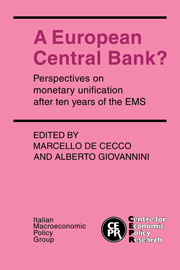Book contents
- Frontmatter
- Contents
- List of figures
- List of tables
- Preface
- List of conference participants
- 1 Does Europe need its own central bank?
- 2 Monetary policy, capital controls and seigniorage in an open economy
- 3 Seigniorage in Europe
- 4 Factor mobility, uncertainty and exchange rate regimes
- 5 Management of a common currency
- 6 The tastes of European central bankers
- 7 The costs and benefits of a European currency
- 8 The monetary unification process in nineteenth-century Germany: relevance and lessons for Europe today
- 9 The establishment of a central bank: Italy in the nineteenth century
- 10 The founding of the Fed and the destabilization of the post-1914 US economy
- 11 Panel discussion on the prospects for a European Central Bank
- Index
8 - The monetary unification process in nineteenth-century Germany: relevance and lessons for Europe today
Published online by Cambridge University Press: 05 February 2012
- Frontmatter
- Contents
- List of figures
- List of tables
- Preface
- List of conference participants
- 1 Does Europe need its own central bank?
- 2 Monetary policy, capital controls and seigniorage in an open economy
- 3 Seigniorage in Europe
- 4 Factor mobility, uncertainty and exchange rate regimes
- 5 Management of a common currency
- 6 The tastes of European central bankers
- 7 The costs and benefits of a European currency
- 8 The monetary unification process in nineteenth-century Germany: relevance and lessons for Europe today
- 9 The establishment of a central bank: Italy in the nineteenth century
- 10 The founding of the Fed and the destabilization of the post-1914 US economy
- 11 Panel discussion on the prospects for a European Central Bank
- Index
Summary
There are few similarities in the discussion and development of the central bank question in the European Community, on the one hand, and in Germany during her unification process in the 19th century, on the other. With economic unification coming before political unification in both cases – the creation of the Zollverein in 1834 and of the European Economic Community in 1957 – one similarity is that the reduction of exchange rate risks and of transaction costs by means of agreements on common monetary standards was aimed at in both cases as part of the creation of an internal market without customs barriers. The statutes of the Zollverein already demanded a standardization of the coinage systems. The Common Market Treaty already obliged every member state to regard its exchange rate policy as a matter of common concern (Art. 107) and created an advisory currency committee (Art. 105). As in the European Community the central bank question surfaced early in debates about the Zollverein's development. Friedrich List promoted the idea of a central note-issuing bank for the Zollverein with headquarters in Berlin in his journal Zollvereinsblatt in 1845. The Prussian government reacted to strong pressure from business circles and from out-of-state competition in note-bank creation and opted for the particularistic state-oriented solution instead of for a centralized Zollverein solution. It established the Prussian Bank as a note-issuing bank under government supervision in 1847.
- Type
- Chapter
- Information
- A European Central Bank?Perspectives on Monetary Unification after Ten Years of the EMS, pp. 216 - 243Publisher: Cambridge University PressPrint publication year: 1989
- 10
- Cited by

